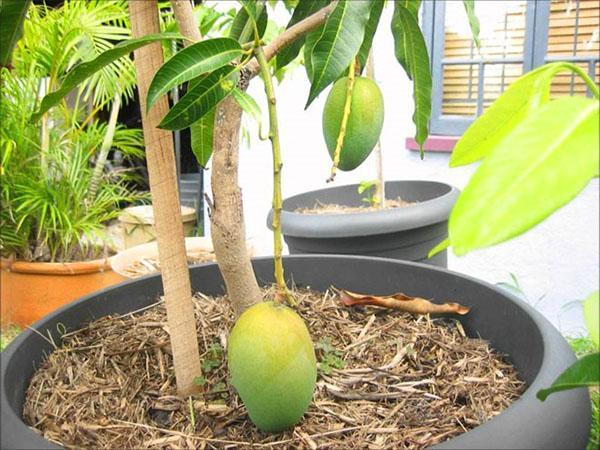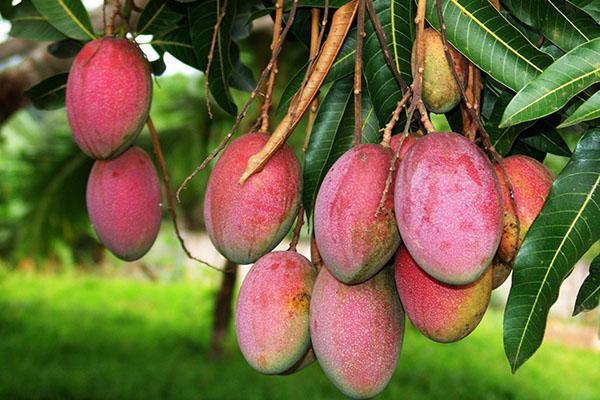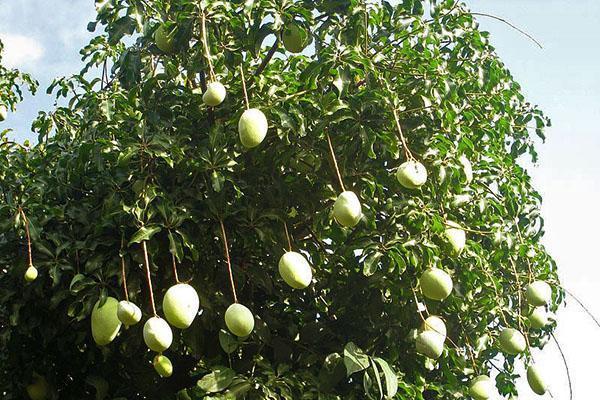A sip of exotic with a mango tree on the windowsill
 How exotic sometimes you want in ordinary home conditions. A tropical mango or mangifera tree on the windowsill will be a worthy exhibit in the apartment. A little hard work and the family will be able to enjoy the dense thickets of this perennial plant. Still, it is worthwhile to understand that the climate of temperate latitudes is in many ways different from the tropics - the area where the mango tree grows. Therefore, it is necessary to ensure the correct fit and decent care for this representative of the Anacardia family.
How exotic sometimes you want in ordinary home conditions. A tropical mango or mangifera tree on the windowsill will be a worthy exhibit in the apartment. A little hard work and the family will be able to enjoy the dense thickets of this perennial plant. Still, it is worthwhile to understand that the climate of temperate latitudes is in many ways different from the tropics - the area where the mango tree grows. Therefore, it is necessary to ensure the correct fit and decent care for this representative of the Anacardia family.
The mango fruit combines pleasant notes of sweetness with a slightly sour aftertaste. The pulp has a delicate texture. However, the peel contains substances that cause allergies in many people.
Read also: money tree care

In wild nature
 This evergreen plant is found in the rainforests of India. In such groves, you can find specimens up to 25 or 30 meters in height. The crown of each of them can grow up to 8 m in diameter. Such a volume is possible thanks to the deciduous plates reaching 40 cm in length. The mango tree has interesting features:
This evergreen plant is found in the rainforests of India. In such groves, you can find specimens up to 25 or 30 meters in height. The crown of each of them can grow up to 8 m in diameter. Such a volume is possible thanks to the deciduous plates reaching 40 cm in length. The mango tree has interesting features:
- at first the leaves have a burgundy hue, but over time they turn green;
- in February / March, yellow inflorescences appear on the buds (they are somewhat similar to the pyramids of Egypt);

- the aroma of these flowers resembles the incense of lilies, so both insects and bats flock to it;
- the root system of the plant is presented in the form of a powerful rod that grows up to 6 m, as well as long branched shoots;
- for 3 months, fruits can be harvested from the trees.

Many members of this genus are centenarians. Some of them are over 300 years old. The whole process of development and growth in them is uneven. In one period of the year, the trunk and branches grow faster than in another. This is due to the fact that the climatic conditions of the tropics and the composition of the soil in different areas may differ. However, at home, the mango tree is a compact ornamental plant. Unfortunately, his height will not exceed one and a half meters.
From seed to sprout
 One of the most famous options for breeding mangifera at home is seed germination. For the first stage of this process, you need to take a glass with a lid to create a humid microclimate for the sprout. But to get the best results in this matter, the following recommendations of gardeners will help:
One of the most famous options for breeding mangifera at home is seed germination. For the first stage of this process, you need to take a glass with a lid to create a humid microclimate for the sprout. But to get the best results in this matter, the following recommendations of gardeners will help:
- the seed should be removed from overripe fruits (they should be soft and reddish in color);
- then you need to open it and get the seed;

- it must be planted immediately, otherwise it will not germinate;
- the grain should be treated with a fungicide (these drugs prevent the development of bacteria and pathogenic fungi);

- the seed is placed in the soil so that the root is directed to the bottom of the pot;

- it is not necessary to deeply deepen it into the ground (the fourth part should rise above the ground level);
- the container should be covered with a cut bottle with a neck (the lid can be unscrewed for airing periodically) or with a film that must be removed when a sprout appears.

If it is not possible to plant the bone immediately, you can wrap it in cotton wool or a towel soaked in water. Moistened sawdust or a glass of plain boiled water will work as well. When the first shoots appear, the germinated seed can be transferred to the ground.
 It is important to prepare the soil and pot before planting.It is best to buy neutral soil, because the mango tree does not tolerate an acidic environment. The diameter of the container should not exceed 12 cm. Among other things, one large or several small holes must be drilled at the bottom of the pot. Before filling it with soil, you need to drain from a layer of expanded clay (up to 5 cm).
It is important to prepare the soil and pot before planting.It is best to buy neutral soil, because the mango tree does not tolerate an acidic environment. The diameter of the container should not exceed 12 cm. Among other things, one large or several small holes must be drilled at the bottom of the pot. Before filling it with soil, you need to drain from a layer of expanded clay (up to 5 cm).
The seed pot must be placed in a well-lit place. The plant should be watered abundantly with warm, settled liquid. In this case, it is important to ensure that water does not stagnate there. The germination process takes 30 to 60 days.
In most cases, several shoots sprout from one seed at once. The strongest and most active of them is the future of the tree. The rest must be carefully removed.
Courtship period
 Florists are most concerned with the question of how to grow a mango tree at home. After all, landing is only half the battle. Housewives understand that every effort should be made so that the seedling begins and begins to grow actively. Moreover, the harvest that the family plans to receive depends on competent care. However, this home gardening item is not destined to come true.
Florists are most concerned with the question of how to grow a mango tree at home. After all, landing is only half the battle. Housewives understand that every effort should be made so that the seedling begins and begins to grow actively. Moreover, the harvest that the family plans to receive depends on competent care. However, this home gardening item is not destined to come true.  The essence of the problem lies in the fact that inflorescences are practically not pollinated at home. This problem even exists on plantations where mango trees are grown commercially.
The essence of the problem lies in the fact that inflorescences are practically not pollinated at home. This problem even exists on plantations where mango trees are grown commercially.
However, this exotic plant can rightfully become another "green pet". In order for the tree to feel at home and grow luxuriantly, it needs to create the appropriate conditions:
- The soil. Black earth for a mangifer is a deadly mixture. Realizing this, the florist needs to give preference to loamy, podzolic or sandy loam soil types.

- Shine. The southern side of the apartment is the best place for the plant to flourish successfully. In winter, you should arrange additional lighting using special lamps.

- Moisture. Potting soil should never be dry. You need to water the flowerpot abundantly - up to 2 times a week. After such procedures, it is advisable to fluff the soil in order to provide the roots with access to oxygen.

- Air. In the tropics, there is always high humidity, so a home-grown mango should be sprayed regularly (3 times a day). In winter, such water procedures are recommended to be stopped, provided there is a sufficiently humid microclimate in the room.

- Transfer. For the first 5 years, this event should be held every year at the beginning of spring. Then this should be done at intervals of 2 or 3 years. Each subsequent transplant container should be slightly larger than the previous one.

- Pruning. Due to the intensive growth, the leading shoot must be pinched. The same should be done with the lateral processes. Pruning is carried out when the plant reaches 70-100 cm in height.

Feeding plays an important role in the courtship process. Without nitrogen-containing fertilizers, the ovaries will be bad, and the fruits will be poor. You can replace them with organic matter. Such substances are introduced on the 15th of July.
 A mango tree can only bear fruit in one case, if it is grafted. To do this, a shoot from a fruitful specimen is grafted to the trunk (at a distance of 2 cm from the roots). A kidney is placed in a T-shaped incision, and then tightly wrapped with duct tape. After 45 days, you need to cut off the top of the main trunk (near the inoculation).
A mango tree can only bear fruit in one case, if it is grafted. To do this, a shoot from a fruitful specimen is grafted to the trunk (at a distance of 2 cm from the roots). A kidney is placed in a T-shaped incision, and then tightly wrapped with duct tape. After 45 days, you need to cut off the top of the main trunk (near the inoculation).  Three years of intensive care and as a result, the first flowers can be seen. In other cases, the mango tree will only serve as a decorative exhibit in a home greenhouse.
Three years of intensive care and as a result, the first flowers can be seen. In other cases, the mango tree will only serve as a decorative exhibit in a home greenhouse.